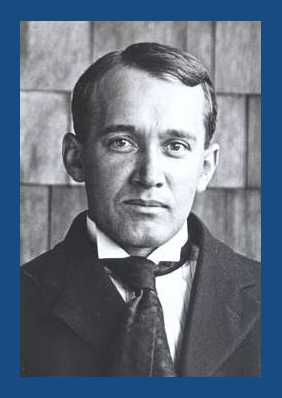
| Vesto Melvin Slipher (1875 - 1969) |
History
This page is motivated by a feeling I have held for some years: that a very large share of the credit for the discovery of the expanding universe is due to Slipher, and yet he tends to take very much second place to Hubble in most accounts. In 2004, I tried and failed to discover electronic versions of Slipher's seminal papers anywhere on the web. This is a disgrace; since ROE is fortunate enough to possess an outstanding collection of historical journals, I was able to track down the originals, and they are made available below. Since then, I am proud to say that my complaints to ADS have had an effect: not only are Slipher's main papers all now listed (the 1917 masterpiece wasn't even in the database), but you can also find the scans I made through ADS.Reading these papers only confirmed my impression that Slipher's work is badly under-valued. They are confidently argued, and make some points that are astonishingly perceptive with the aid of 21st-century hindsight.
- The 1913 paper measured the blueshift of Andromeda to be 300 km/s. This is very high by the standards of the time (cf. the quasar redshift controversy). Slipher trenchantly asserts that "...we have at the present no other interpretation for it. Hence we may conclude that the Andromeda Nebula is approaching the solar system...". Since the blue shift is now believed to be induced by dark-matter density perturbations, it is amusing to note Slipher's speculation that the nebula "might have encountered a dark star".
- The 1914 paper was unknown to me, but appears to be the first demonstration that spiral galaxies rotate. Tully-Fisher started here. This would make Slipher a figure of importance, even if he had done nothing else.
- The 1915 paper is the classic, in which Slipher presented his results to the American Astronomical Society (August 1914 meeting). Out of 15 galaxies, 11 were clearly redshifted. He received a standing ovation.
- The 1917 paper is perhaps the most interesting. The redshift:blueshift ratio has now risen to 21:4, but it is the interpretation that is startling, since Slipher notes that we are not at rest with respect to the other galaxies on average. He deduces a mean velocity of 700 km/s and makes a tremendous intellectual leap: "For us to have such motion and the stars not show it means that our whole stellar system moves and carries us with it. It has for a long time been suggested that the spiral nebulae are stellar systems seen at great distances ... This theory, it seems to me, gains favor in the present observations". This, remember, is 8 years before Hubble resolved Andromeda into stars and settled the "island universe" question. One could take the view that Slipher missed the main point of his data, which was the expanding universe, but this seems rather unfair given the neatness of the argument that Slipher uses here. His argument seems wonderfully modern, given the subsequent measurement of large-scale peculiar velocities in cosmology.
- By this time, the theorists were on the march, and there were soon reasons to look for a linear relation between redshift and distance. A number of people (Wirtz, Roberston) tried this, and the 1924 paper by Lundmark is impressive. In general, distances to galaxies were lacking at that time, although the detection of Novae in M31 had suggested a distance around 500 kpc, which is not too far off. What Lundmark does is assume that galaxies are standard objects, and he deduces distances in units of the M31 distance, based on diameters and on apparent magnitudes (these agree reasonably well). The distances clearly correlate with Slipher's redshifts, as shown in Lundmark's figure 5. The expanding universe can fairly be regarded as pretty well established observationally by this stage, although the theoretical understanding of what a linear distance-redshift relation meant still had some way to go.
Further details
Slipher's pioneering work was the subject of a conference in Flagstaff Arizona, held in September 2012 to mark the 100th anniversary of Slipher's first successful observation of M31. My paper from that meeting gives more details of the above arguments, as well as a full statistical re-analysis of Slipher's data. An interesting point emerges from this concerning what can be said about expansion on the basis of what was known in 1917. Slipher did not claim that velocities had a general tendency to be redshifts because he was able to reduce the mean redshift very significantly by removing the dipole signal due to the motion of the Sun. But in fact the remaining mean redshift is significantly positive (at 8sigma; rising to 14sigma with the expanded data that Slipher gave to Eddington in 1923). Thus Slipher had in his possession clear evidence for a general recession of the nebulae, the best part of a decade before Hubble came on the scene.
Papers
- Slipher (1913): Lowell Observatory Bulletin, 58, 56
- Slipher (1914): Lowell Observatory Bulletin, 62
- Slipher (1915): Popular Astronomy, 23, 21
- Slipher (1917): Proc. Amer. Phil. Soc., 56, 403
- Lundmark (1924): MNRAS, 84, 747
Links
- Lowell Observatory biography
- The Bruce Medallists biography
- Talks from the 2012 Flagstaff Conference